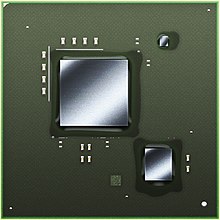Espresso (processor)
 An illustration of the Wii U MCM without heat spreader. The smaller chip, lower right, is the "Espresso" CPU made by IBM. The other chips are the "Latte" GPU (large chip) from AMD and an EEPROM chip (tiny) from Renesas. | |
| General information | |
|---|---|
| Launched | 2012 |
| Discontinued | Present |
| Designed by | IBM and Nintendo |
| Common manufacturer |
|
| Architecture and classification | |
| Application | Wii U |
| Technology node | 45 nm |
| Microarchitecture | PowerPC 1.10 |
| Instruction set | Power Architecture |
| Physical specifications | |
| Cores |
|
| History | |
| Predecessor | Broadway |
| POWER, PowerPC, and Power ISA architectures |
|---|
| NXP (formerly Freescale and Motorola) |
| IBM |
|
| IBM/Nintendo |
| Other |
| Related links |
| Cancelled in gray, historic in italic |
Espresso is the codename of the central processing unit (CPU) used in Nintendo's Wii U video game console. It was designed by IBM, and is currently being produced using a 45 nm Silicon on insulator process. The Espresso chip resides together with a GPU from AMD on a MCM manufactured by Renesas. It was revealed at E3 2011 in June 2011 and released in November 2012.
Design

IBM and Nintendo have revealed that the Espresso processor is a Power Architecture based microprocessor with three cores on a single chip to reduce power consumption and increase speed. The CPU and the graphics processor are placed on a single substrate as a multi-chip module (MCM) to reduce complexity, increase the communication speed between the chips, further reduce power consumption and reduce cost and space required. The two chips were assembled to the complete MCM by Renesas in Japan.[1] Espresso itself is manufactured by IBM in its 300 mm plant in East Fishkill, New York, using 45 nm SOI-technology[2] and embedded DRAM (eDRAM) for caches.
While unverified by Nintendo hackers, teardowns and unofficial informants have since revealed more information about the Espresso, such as its name,[3] size[4][5] and speed.[6][7] The microarchitecture seems to be quite similar to its predecessors the Broadway and Gekko, i.e. PowerPC 750 based, but enhanced with larger and faster caches and multiprocessor support.
Speculation concerning POWER7
A lot of disinformation and misinformation was spread the years before the release, and one of the most prevailing was the notion that the Wii U CPU was derived from IBM's high end POWER7 server processor. This rumor was sparked by a comment from IBM stating that Espresso uses "the same processor technology found in Watson",[8] which was interpreted as Wii U was using POWER7 as Watson does.[9][10] That was later falsely confirmed by IBM's Watson team on Twitter[11] but that was later redacted by IBM and confirmed to be false.[12] Espresso shares some technology with POWER7, such as eDRAM and Power Architecture, but those are superficial similarities.
Specifications
- Out-of-order execution PowerPC based cores
- 45 nanometer process technology
- IBM silicon on insulator (SOI) technology
- Backward compatible with the Broadway and Gekko processors
The following specifications have not been officially confirmed by either Nintendo nor IBM.
- Broadway based core architecture[13]
- Three cores at 1.243125 GHz
- 32-bit integer unit
- 64-bit floating-point (or 2 × 32-bit SIMD, often found under the denomination "paired singles")
- A Total of 3 MB of Level 2 cache in an unusual configuration.[14]
- core0 = 512 kB, core1 = 2 MB, core2 = 512 kB
- Die size: 4.74 mm × 5.85 mm = 27.73 mm2
References
- ^ Iwata asks: Wii U: The Console
- ^ NEW WII U™ ON SOI
- ^ World Exclusive: Wii U Final Specs
- ^ Nintendo Wii U Teardown - AnandTech.com
- ^ Nintendo Wii U Teardown - iFixit.com
- ^ Wii U has 1.24GHz CPU, 550MHz graphics core
- ^ Wii U CPU, GPU Details Uncovered
- ^ IBM puts Watson's brains in Nintendo Wii U
- ^ IBM teases on Wii U CPU specs
- ^ Rumored Wii U Specs Raising Eyebrows... for the Wrong Reasons
- ^ IBM reconfirms the Wii U/Watson connection
- ^ IBM Confirms WII U Utilizes Power-Based CPU, Not Power 7
- ^ @marcan42, Twitter - 2012-12-09
- ^ @marcan42, Twitter - 2013-01-30
